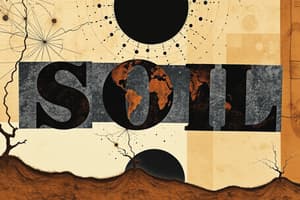Podcast
Questions and Answers
What is the primary reason for the decrease in storage capacity of reservoirs due to soil erosion?
What is the primary reason for the decrease in storage capacity of reservoirs due to soil erosion?
- Accumulation of silt in reservoirs (correct)
- Soil sedimentation at the riverbed
- Change in the course of direction of rivers
- Reduced moisture retention capacity of soil
Which of the following is not a measure to prevent soil erosion?
Which of the following is not a measure to prevent soil erosion?
- Contour cultivation
- Over-irrigation (correct)
- Construction of check dams
- Proper use of water
What is the difference between soil management and soil conservation?
What is the difference between soil management and soil conservation?
- Soil management focuses on increasing agricultural produce, while soil conservation focuses on protecting fertility
- Soil management focuses on protecting fertility, while soil conservation focuses on both protecting fertility and using soil in a healthy way (correct)
- Soil management focuses on protecting fertility, while soil conservation focuses on increasing agricultural produce
- Soil conservation is a part of soil management
What is the effect of soil erosion on groundwater?
What is the effect of soil erosion on groundwater?
Which of the following is a cause of soil erosion?
Which of the following is a cause of soil erosion?
What is the area of alluvial soil in India?
What is the area of alluvial soil in India?
Which type of soil is also called as 'Black Cotton Soil' or 'Regur Soil'?
Which type of soil is also called as 'Black Cotton Soil' or 'Regur Soil'?
Which type of soil has the most decayed and dead organic matter?
Which type of soil has the most decayed and dead organic matter?
Which type of soil has the lowest moisture retention capacity?
Which type of soil has the lowest moisture retention capacity?
In which state is the largest area of alluvial soil found?
In which state is the largest area of alluvial soil found?
Which crop is commonly grown in the mountain soil?
Which crop is commonly grown in the mountain soil?
Which type of soil has oxides of lime and magnesium?
Which type of soil has oxides of lime and magnesium?
Which type of soil is formed by the weathering of igneous rocks?
Which type of soil is formed by the weathering of igneous rocks?
Flashcards
Alluvial Soil
Alluvial Soil
Soil that covers 7.7 million square kilometers, good for wheat, paddy, sugarcane, jowar, jute and cotton.
Black Soil
Black Soil
Soil that covers 5.46 lakh square kilometers, ideal for cotton, wheat, paddy, jute, and sugarcane.
Red Soil
Red Soil
Soil covering 5.18 lakh square kilometers, suitable for oilseeds, ragi, and tobacco.
Laterite Soil
Laterite Soil
Signup and view all the flashcards
Desert Soil
Desert Soil
Signup and view all the flashcards
Mountain Soil
Mountain Soil
Signup and view all the flashcards
Soil Erosion
Soil Erosion
Signup and view all the flashcards
Afforestation
Afforestation
Signup and view all the flashcards
Terrace Farming
Terrace Farming
Signup and view all the flashcards
Construction of Bunds and Check Dams
Construction of Bunds and Check Dams
Signup and view all the flashcards
Soil Management
Soil Management
Signup and view all the flashcards
Soil Conservation
Soil Conservation
Signup and view all the flashcards
Study Notes
Soil Types in India
- There are 6 types of soils in India: Alluvial, Black, Red, Laterite, Desert, and Mountain soil.
Alluvial Soil
- Covers an area of 7.7 million square kilometers
- Crops grown: Wheat, Paddy, Sugarcane, Jowar, Jute, Cotton
- Found in states: Uttar Pradesh, West Bengal, Bihar, Orissa, and Assam
- Facts: The Indian Alluvial Tract is the largest in the world
Black Soil
- Covers an area of 5.46 lakh square kilometers
- Crops grown: Cotton, Wheat, Paddy, Jute, Sugarcane
- Found in states: Maharashtra, Goa, Karnataka, Tamil Nadu, and Andhra Pradesh
- Facts: Also called 'Black Cotton Soil' or 'Regur Soil', it has oxides of lime and magnesium, and is best for cotton cultivation
Red Soil
- Covers an area of 5.18 lakh square kilometers
- Crops grown: Oilseeds, Ragi, Tobacco
- Found in states: Kanyakumari to Madhya Pradesh and Gujarat to Rajmahal Hills
- Facts: Most widely spread soil in the Peninsular Plateau
Laterite Soil
- Covers an area of 2.48 lakh square kilometers
- Crops grown: Coffee, Tea, Areca nut, and other plantation crops
- Found in states: Western Ghats, Satpuras, Poorvanchal, Rajmahal Hills, and Vindhyas
- Facts: Red in color, lacks nitrogen and minerals, and has insoluble oxides of iron and aluminum
Desert Soil
- Covers an area of 1.4 lakh square kilometers
- Crops grown: Sajje, Dates, Jowar
- Found in states: Gujarat, Rajasthan, Punjab, and Haryana
- Facts: Red and brown in color, has low moisture retention capacity
Mountain Soil
- Crops grown: Spices, Fruits, Coffee, Tea
- Found in states: Jammu and Kashmir, Himachal Pradesh, West Bengal, Uttarakhand, and Siwaliks
- Facts: Contains the most decayed and dead organic matter, making it the most fertile and rich in nitrogen and minerals
Soil Erosion
- Causes: Deforestation, Overgrazing, Over-irrigation, Unscientific methods of cultivation, and manufacture of bricks and tiles
- Effects:
- Accumulation of silt in river beds and reservoirs
- Reduced moisture retention capacity of soil
- Change in course of direction of rivers
- Reduced storage capacity of reservoirs
- Frequent floods
- Decreased groundwater level
- Measures to prevent soil erosion:
- Afforestation
- Reduce deforestation
- Terrace farming
- Construction of bunds and check dams
- Proper use of water
- Prevention of overgrazing
- Contour cultivation
Soil Management and Conservation
- Soil management: Protecting the fertility of the soil
- Soil conservation: Protecting the fertility of the soil and using it in a healthy way to increase agricultural produce
Studying That Suits You
Use AI to generate personalized quizzes and flashcards to suit your learning preferences.




